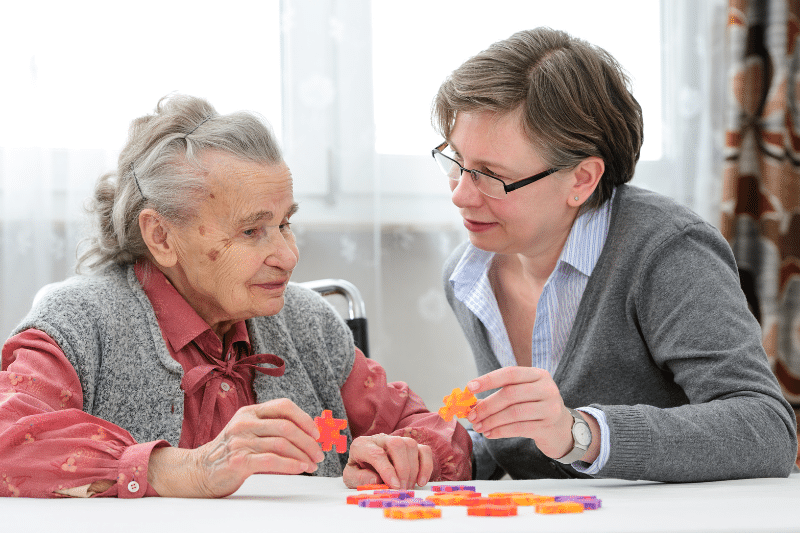Dementia is a cognitive condition known to affect millions worldwide with memory and behavioural issues. For caregivers and loved ones, communicating with a dementia patient can be both complex and frustrating due to these issues.
However, various strategies can be used to enhance daily interactions. Making talking a more meaningful experience and less stressful for all parties involved. This article will outline some of the most effective ways to communicate with dementia patients.
Understanding Dementia
Before we get into the communication strategies that can be used with dementia patients, it is important to first understand the condition itself. That way, we can comprehend what areas of communication they may have difficulty with and how interested parties can learn to support them during conversations.
Dementia itself is actually an umbrella term for several different conditions associated with cognitive decline. In particular, signs of dementia tend to be cognitive complications that interfere with the affected person’s daily life. The most common type is Alzheimer’s disease, but there are multiple varieties that affect a person in unique ways.
For those living with dementia, however, they are likely to experience the following:
- Memory loss or difficulty recalling memories
- Difficulty understanding or using language
- Mood swings
- Bouts of confusion
- Impaired judgement
Such conditions can make communication difficult at times, necessitating patience, empathy, and tailored strategies. Much like the ones we will be describing below
Effective Communication Strategies
If you are invested in improving the standard of communication you have with a dementia patient, there are some simple strategies you can follow. These strategies will not automatically make a dementia patient capable of perfect speech or rationalisation, but certain ones may aid in improving their mood and allowing their needs to be clarified.
1. Simplify Your Language
The first strategy is as easy as simplifying your language. When around someone who has dementia, switch your language to simple wording that can be easily understood. This means avoiding long sentences and complex vocabulary.
Always break down your messages into short, manageable chunks for the patient. Then, allow them the time to process such words before moving on. This level of patience and clarity can make it easier to communicate with someone who has dementia, thereby allowing them to understand what is going on in the world around them.
2. Use Non-Verbal Cues
Words do not have to be the only means of communicating with a dementia patient. A lot can be conveyed with non-verbal efforts like body language, gestures, and facial expressions. Assure a patient by smiling, making eye contact, and using gentle touches if accepted. Demonstrating what you are saying through your actions can help bridge the gap when words fail.
3. Be Patient and Supportive
Above all else, communication with a dementia patient is about being patient. Responses may take a long time to be formed, or the patient may have difficulty understanding your words at first.
Resist the urge to interrupt their slowed speech or to finish their sentences for them. Autonomy is important to those with dementia, so allow them to exercise it during conversation. This will help in maintaining both the physical and emotional well-being of the patient as they exercise their speech capacity and connect to others.
Additionally, due to many patients having difficulty recognising their surroundings or people at times, you do not want to do anything that heightens this confusion or anxiety. This includes showing frustration or impatience during communication efforts. Rather, take the time to regularly offer reassurance and encouragement, validating their efforts to communicate.
4. Establish a Routine
Security in dementia patients’ lifestyle is key for their peace of mind, so try and keep things consistent. Setting a daily routine and maintaining it can reduce a patient’s overall confusion. Thus, making communication easier at times.
Familiarity in a patient’s settings and routine allows them to begin to anticipate what comes next. So, when you regularly ask questions about their well-being or needs at the same time every day, they are more likely to understand and respond due to anticipation.
5. Limit Distractions
Communication can go more smoothly when there are no distractions to the patient. When initiating conversation, create a calm, quiet environment by turning off sources of noise like TV or radio. Reduction of visual clutter can also help a patient focus more on the conversation at hand. Allowing them to get overwhelmed can become a stressful situation and prevent them from focusing on the conversation.
6. Ask Simple Questions
Rather than asking open-ended questions, which can be overwhelming or difficult for a patient, ask one with set answers. This can be simple yes/no questions, but you can also change how you would ask more common questions.
For example, instead of asking, “What would you like for lunch?” you could ask, “Would you like a sandwich or soup for lunch?” That way, answers can be given succinctly without any huge effort on the patient’s behalf and you get a clear line of communication.
7. Listen Actively
Communication is a two-way street, so it is important to use active listening with a patient. This involves more than just hearing words, but also understanding their facial expressions, tone of voice, and body language. Such elements can provide crucial clues to their feelings and needs during necessary conversations.
You can demonstrate your active listening clearly by nodding, maintaining eye contact, and responding appropriately. Remember, short yet clear responses in a patient tone.
8. Use Visual Aids
If verbal or physical communication is not quite connecting with a patient, visual aids are a useful alternative to consider. Using pictures or written signs to explain verbal statements can help patients better comprehend what message is being conveyed. The aids can also be kept to help them jog their memory when needed.
Straight signage is not the only means of visual aid that can be used. Labelling household items and storage can help patients navigate their surroundings and find what they need without assistance. Additionally, photo albums can help jog their memory of certain places, people and events, granting them context for a conversation and preventing them from being confused.
9. Maintain a Positive Attitude
The attitude you bring to a conversation can actively change its effectiveness. When you enter a conversation angry or short of patience, it creates an uncomfortable environment that can become overwhelming for patients. Instead, use a positive and friendly demeanour to put them at ease and lessen communication stress.
You can project a calming presence by using a warm tone of voice, smiling, and showing genuine interest in a patient’s words. This positivity can become contagious, easing any lingering anxiety and encouraging patients to interact with others.
10. Be Flexible
The last strategy to improve communication with dementia patients is allowing yourself to be flexible with the other strategies. You may need to adapt your usual strategy depending on the patient’s abilities that day and/or their mood.
Some days living with dementia can be easier than others, so be ready to adjust your approach to communicatuon as needed. When a certain strategy is not working, be adaptable enough to try a different one until you find the solution.
Communication is Key
Ultimately, effective communication with dementia patients lies in your ability to provide patience, empathy, and a willingness to adapt strategies when needed. By following the strategies outlined in this article, you can discover what works best for your patient. Such a supportive environment can enhance both caregivers and loved ones’ interactions with patients, improving the collective’s quality of life and well-being.
Remember, every person with dementia is unique, and what works for one individual may not work for another. Continuous learning and adjustment are key to successful communication.





